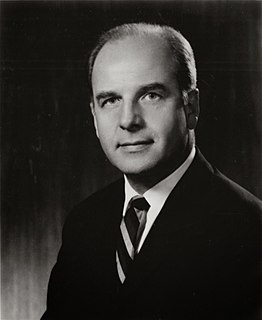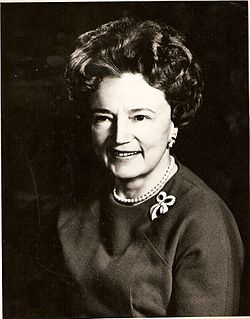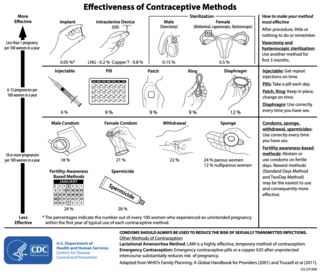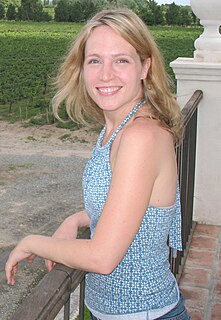Related Research Articles

Emergency contraception (EC) is a birth control measure, used after sexual intercourse to prevent pregnancy.

The combined oral contraceptive pill (COCP), often referred to as the birth control pill or colloquially as "the pill", is a type of birth control that is designed to be taken orally by women. It includes a combination of an estrogen and a progestogen. When taken correctly, it alters the menstrual cycle to eliminate ovulation and prevent pregnancy.

Gaylord Anton Nelson was an American politician and environmentalist from Wisconsin who served as a United States Senator and governor. He was a member of the Democratic Party and the founder of Earth Day, which launched a new wave of environmental activism.

Levonorgestrel is a hormonal medication which is used in a number of birth control methods. It is combined with an estrogen to make combination birth control pills. As an emergency birth control, sold under the brand name Plan B among others, it is useful within 72 hours. This should not be confused with EllaOne which can be effective within 120 hours of unprotected sex. The more time that has passed since sex, the less effective the medication becomes, and it does not work after pregnancy (implantation) has occurred. It decreases the chances of pregnancy by 57 to 93%. In an intrauterine device (IUD), such as Mirena among others, it is effective for the long-term prevention of pregnancy. A levonorgestrel-releasing implant is also available in some countries.
Progestogen-only pills or progestin-only pills (POP) are contraceptive pills that contain only synthetic progestogens (progestins) and do not contain estrogen. They are colloquially known as mini pills.

Norethisterone acetate (NETA), also known as norethindrone acetate and sold under the brand name Primolut-Nor among others, is a progestin medication which is used in birth control pills, menopausal hormone therapy, and for the treatment of gynecological disorders. The medication available in low-dose and high-dose formulations and is used alone or in combination with an estrogen. It is taken by mouth.

Edris Roushan Rice-Wray, was a pioneer in medical research who helped to prove the worth of the oral contraceptive pill. Her work on the birth control injection pill is especially notable as medical research was influential in the creation of the birth control pill. Dr. Rice-Way headed a large scale, clinical trial of the first birth control pill in the late 1950s in Puerto Rico.
Hormonal contraception refers to birth control methods that act on the endocrine system. Almost all methods are composed of steroid hormones, although in India one selective estrogen receptor modulator is marketed as a contraceptive. The original hormonal method—the combined oral contraceptive pill—was first marketed as a contraceptive in 1960. In the ensuing decades many other delivery methods have been developed, although the oral and injectable methods are by far the most popular. Hormonal contraception is highly effective: when taken on the prescribed schedule, users of steroid hormone methods experience pregnancy rates of less than 1% per year. Perfect-use pregnancy rates for most hormonal contraceptives are usually around the 0.3% rate or less. Currently available methods can only be used by women; the development of a male hormonal contraceptive is an active research area.

Barbara Seaman was an American author, activist, and journalist, and a principal founder of the women's health feminism movement.

There are many methods of birth control, they vary in what is required of the user, side effects, and effectiveness. It is also important to note that not every method of birth control is ideal for each user. Outlined here are the different types of barrier methods, hormonal methods, various methods including spermicides, emergency contraceptives, and surgical methods.
The National Women's Health Network (NWHN) is a non-profit women's health advocacy organization located in Washington, D.C. It was founded in 1975 by Barbara Seaman, Alice Wolfson, Belita Cowan, Mary Howell, and Phyllis Chesler. The stated mission of the organization is to give women a greater voice within the healthcare system. The NWHN researches and lobbies federal agencies on such issues as AIDS, reproductive rights, breast cancer, older women's health, and new contraceptive technologies. The Women's Health Voice, the NWHN's health information program, provides independent research on a variety of women's health topics.
Alice Wolfson is an American activist. A Barnard College graduate and former Fulbright Scholar, she is a veteran political activist in women's reproductive health issues, a lawyer, and a co-founder of the National Women's Health Network.
Mestranol/norethynodrel was the first combined oral contraceptive pill (COCP) being mestranol and norethynodrel. It sold as Enovid in the United States and as Enavid in the United Kingdom. Developed by Gregory Pincus at G. D. Searle & Company, it was first approved on June 10, 1957 by the U.S. Food and Drug Administration for treatment of menstrual disorders. The FDA approved an additional indication for use as a contraceptive on June 23, 1960, though it only became legally prescribable nationwide and regardless of the woman's marital status after Eisenstadt v. Baird in 1972. In 1961, it was approved as a contraceptive in the UK and in Canada.

Sandra Kay Fluke is an American lawyer and women's rights activist.

Laura Eldridge is a women's health writer and activist. She began working with the legendary women's health activist and author of The Doctor's Case Against The Pill, Barbara Seaman, when studying at Barnard College. She is co-author of The No-Nonsense Guide To Menopause as well as the co-editor, also with Barbara Seaman, of Voices of the Women's Health Movement a collection of essays, interviews, and commentary by leading activists, writers, doctors, and sociologists on topics ranging across reproductive rights, sex and orgasm, activism, motherhood and birth control. She is also the author of In Our Control: The Complete Guide to Contraceptive Choices for Women.
The first large-scale human trial of the birth control pill was carried out in Puerto Rico in the 1950s. Between conceptualization and legalization of the first birth control drug in the United States in 1960, there were many developments and trials of test drugs. One such trial happened in Puerto Rico in the 1950s. Before the drug was approved as safe in the mainland U.S., many Puerto Rican women were tested on. The trials were conducted by Gregory Pincus and John Rock in 1955. These trials are a major component in the history of the development of female oral contraceptives, in between initial small trial testing on the east coast and the release of the drug for public consumption.
Sybil Shainwald is an American attorney specializing in women's health law and an activist for women's health reform. She has represented thousands of women and their children in individual and class action suits against manufacturers of harmful drugs, devices, and procedures. Shainwald is former chair of the National Women's Health Network, co-founder of Health Action International and Trial Lawyers for Public Justice.
Belita Cowan was a women's health activist during the 1960s and 1970s. She attended the University of Michigan in Ann Arbor. She worked part-time at the University Hospital while finishing her master's degree in English. Cowan started her research as a result of how horrified she was by the false advertising of the morning after pill. She was invited to present her research findings at the Senate hearing on DES in 1974. This made her the first women's health activist to ever testify as an expert witness.

Combined hormonal contraception (CHC), or combined birth control, is a form of hormonal contraception which combines both an estrogen and a progestogen in varying formulations.
The women's health movementin the United States refers to the aspect of the American feminist movement that works to improve all aspects of women's healthcare. It began during the second wave of feminism as a sub-movement of the women's liberation movement. WHM activism involves increasing women's knowledge and control of their own bodies on a variety of subjects, such as fertility control and home remedies, as well as challenging traditional doctor-patient relationships, the medicalization of childbirth, misogyny in the health care system, and ensuring drug safety.
References
- Barbara Seaman, "The Pill and I: 40 Years on, the Relationship Remains Wary", New York Times, June 25, 2000, https://query.nytimes.com/gst/fullpage.html?res=9A04E0D7113FF936A15755C0A9669C8B63&sec=health&pagewanted=2
- "The Pill and the Doctor/Patient Relationship," PBS transcript, https://www.pbs.org/wgbh/amex/pill/filmmore/pt.html